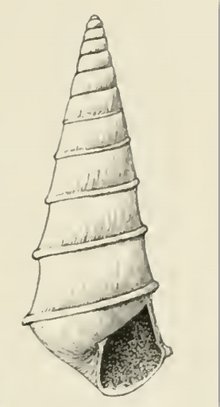Pseudoscilla babylonia
| Pseudoscilla | |
|---|---|
 | |
| Apertural view of Pseudoscilla babylonia | |
| Scientific classification | |
| Kingdom: | Animalia |
| Phylum: | Mollusca |
| Class: | Gastropoda |
| (unranked): | clade Heterobranchia clade Euthyneura clade Panpulmonata |
| Superfamily: | Pyramidelloidea |
| Family: | Pyramidellidae |
| Genus: | Pseudoscilla |
| Species: | P. babylonia |
| Binomial name | |
| Pseudoscilla babylonia (C. B. Adams, 1845) [1] | |
| Synonyms | |
| |
Pseudoscilla babylonia, common name the Babylon pyram, is a species of small sea snail, a marine gastropod mollusk in the family Pyramidellidae, the pyrams and their allies.[2][3][4]
Description
The elongate-conic shell has a light yellowish-brown color, excepting the umbilical area, the extreme basal portion and the tip, which are white. The shell measures 3 mm. The whorls of the protoconch are very small. Their sculpture is decorated with spiral ribs in contrast to almost all species in Pyramidellidae where the sculpture of the protoconch is smooth. The ten post-nuclear whorls are flattened, separated by a scarcely impressed suture. On the last three turns the whorls are marked at the periphery by an exceedingly strong, acute, spiral keel, which is slightly bent downward. The base of the body whorl is short and well rounded. The entire surface of spire and the base are smooth, except for exceedingly fine, incremental lines. The aperture is oval. The posterior angle is acute. The outer lip rendered by the spiral keel in the shape of an accolade. The inner lip is slender, evenly curved, very slightly revolute. The parietal is well glazed with a thin callus.[5]
Distribution
The type specimen was found in the Pacific Ocean off San Hipolito Point, Lower California. But the species has a wide distribution and also occurs in the Caribbean Sea, the Gulf of Mexico and the Lesser Antilles; in the Atlantic Ocean off the Canary Islands, Cape Verdes and Eastern Brazil.
References
- ↑ C. B. Adams, Bost. Proc., p. 6, 1846
- ↑ WoRMS (2010). Pseudoscilla babylonia (C.B. Adams, 1845). Accessed through: World Register of Marine Species at http://www.marinespecies.org/aphia.php?p=taxdetails&id=420459 on 2011-11-27
- ↑ Turgeon, D.; Quinn, J.F.; Bogan, A.E.; Coan, E.V.; Hochberg, F.G.; Lyons, W.G.; Mikkelsen, P.M.; Neves, R.J.; Roper, C.F.E.; Rosenberg, G.; Roth, B.; Scheltema, A.; Thompson, F.G.; Vecchione, M.; Williams, J.D. (1998). Common and scientific names of aquatic invertebrates from the United States and Canada: mollusks. 2nd ed. American Fisheries Society Special Publication, 26. American Fisheries Society: Bethesda, MD (USA). ISBN 1-888569-01-8. IX, 526 + cd-rom pp. (look up in IMIS) page(s): 111.
- ↑ Rosenberg, G., F. Moretzsohn, and E. F. García. 2009. Gastropoda (Mollusca) of the Gulf of Mexico, Pp. 579–699 in Felder, D.L. and D.K. Camp (eds.), Gulf of Mexico–Origins, Waters, and Biota. Biodiversity. Texas A&M Press, College Station, Texas.
- ↑ Proceedings of the United States National Museum 42:287-288 Odostomia (Scalenostoma) babylonia